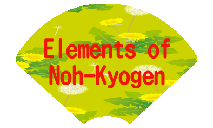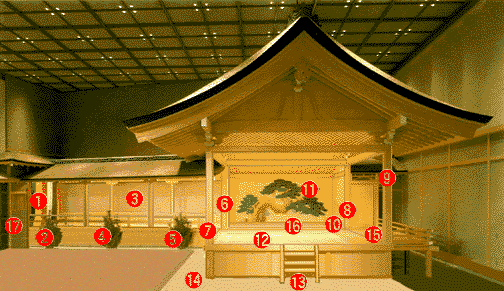
| Background to Noh-Kyogen | Elements of Noh-Kyogen |  Announcing Noh Training Programs Announcing Noh Training Programs |

INSTRUMENTALISTS
| Instrumentalists known as hayashi sit at the back of the stage. They consist of a transverse flute (nohkan), an hourglass-shaped drum held at the shoulder (kotsuzumi), a slightly larger hourglass-shaped drum placed on the lap (okawa or otsuzumi), and a barrel-shaped drum placed on a small floor stand and played with two sticks (taiko). The rhythms and melody of these instruments follow highly prescribed systems. One particularly unique feature is the use of drum calls (kakegoe), the shouts or cries of the drummers which serve as signals between the drummers as well as between the drummers and singers. These drum calls also add an important element to the sound texture of the performance. |
 Nohkan |
 Ko-tsuzumi |
 O-tsuzumi |
 Taiko |
MOVEMENT
| A performance of Noh is not a performance of realistic theatre. Rather, its movement is highly stylized and prescribed. While some gestures have specific meaning, others serve as an abstract aesthetic expression to convey the emotions of the main character. All of Noh can be described as dance. Sometimes there is very little movement as dramatic tension is built mainly through narration. At other times there is strong, vigorous movement. Movement takes place sometimes to the singing of the chorus or sometimes to purely instrumental music. In general, deliberateness, brevity, suppression and abstraction are important features of Noh movement. |

A symbolic movement pattern
:weeping (Sumidagawa)
MASKS
| Makeup is not used in Noh. Rather, delicately carved masks are usually used by the shite main character and/or the tsure attend-ant. These masks are considered objects of superb beauty as well as powerful means of expression. Any character being portrayed which is not a middle aged man living in the present will wear a mask. There-fore all characters portraying women and old men wear masks as well as supernatural beings such as ghosts, deities, demons, and divine beasts. In general, masks either have a more or less neutral express-ion or portray a very strong emotion. The former in fact allows the mask a variety of expression with the play of light and shadow on it as the actor changes slightly the tilt of the mask. Even in roles in which an actor does not wear a mask, the sense of a masked face is evident. This is called hitamen, literally gdirect mask." For this, the actor does not use his face for realistic expression but rather for mask-like expression. |
EXAMPLE
| WOMAN MASK |
MALE MASK |
OLDMAN MASK |
DEMON GOD MASK |
|
|
|
||||
 Ko-omote |
 Hannya |
 Chujo |
 Ko-jo |
 O-tobide |
COSTUMES
| Costumes in Noh are elaborately made with gorgeously dyed silk. These costumes reveal the type of character being portrayed and follow prescribed conventions as to their use. Still, there is much variety. The detail of design, the color combinations, the rich-ness of texture, and the strength of form give noh its visual impact. All characters, whether rich or poor, young or old, male or female, are all beautifully costumed. The costuming process is complex. Rather than the actor putting on his own costume, two or three costumers are needed to sculpt the costume on the actor. |
 Woman |
 Heavenly-being |
 Demoness |
 Old man |
 Warrior |
 Demon god |
STAGE

| 1.Curtain 2.Third Pine 3.Bridge 4.Second Pine 5.First Pine 6.Shite pillar 7.Eye-fixing pillar 8.Flute pillar 9.Waki pillar 10.Cut-through door 11.Back panel 12.Main Stage 13.Moat Steps 14.Pebble Moat 15.Side Stage 16.Rear Stage 17.Mirror Room The curtainless stage used in Noh is square with a bridge-way leading to it from backstage over which the characters make their entrances and exits. Stages were traditionally outside and covered with a long sloping roof. During the last century they have been moved inside. These inside stages are open on two sides in a kind of semi-theater-in-the-round. There is no attempt at designing a realistic stage set. Rather, only symbolic stage properties are used. The pine tree painted on the back wall of the stage represents the tree through which Noh was, by legend, passed down from heaven to mankind. In Japanese culture, the evergreen pine has come to be an important symbol of longevity and unchanging steadfastness. |
SPACE AND TIME
| In general, the use of space and time is not portrayed realistically. Rather, there is a freedom of portrayal which requires the audience members to use their imaginations. Characters take only a few steps and through their song or that of the chorus, the audience knows that they have travelled a great distance. Two characters may appear on the stage nearly side by side but again the audience comes to understand that they are not yet in each other's prescence.While this may be confusing for the first time viewer, for many people who come to understand these and other conventions, Noh creates a much more powerful theatre than realistic theatre. (Associate Professor, Noh Research Archives, Musashino Women's College, Tokyo) |
| (Compiled by Richard Emmert) |
 |
 |
 |